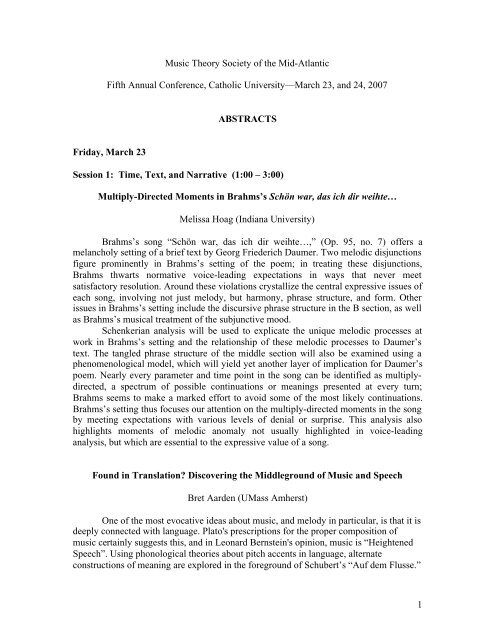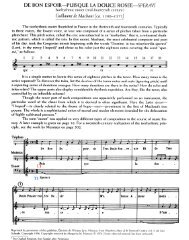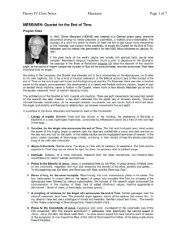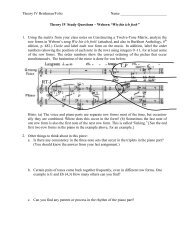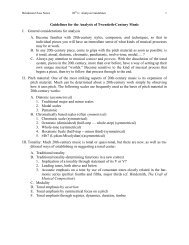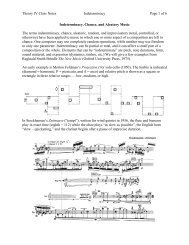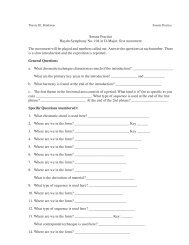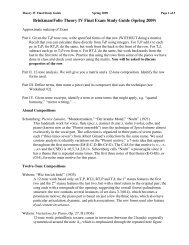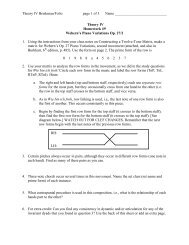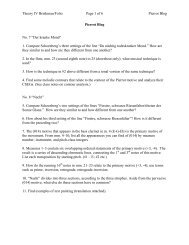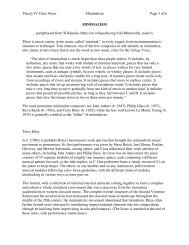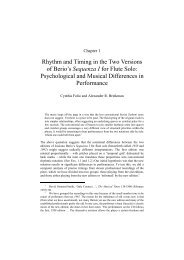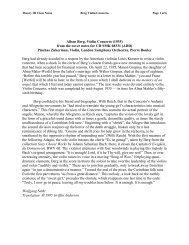Create successful ePaper yourself
Turn your PDF publications into a flip-book with our unique Google optimized e-Paper software.
Music Theory Society of the Mid-AtlanticFifth Annual Conference, Catholic <strong>University</strong>—March 23, and 24, 2007ABSTRACTSFriday, March 23Session 1: Time, Text, and Narrative (1:00 – 3:00)Multiply-Directed Moments in Brahms’s Schön war, das ich dir weihte…Melissa Hoag (Indiana <strong>University</strong>)Brahms’s song “Schön war, das ich dir weihte…,” (Op. 95, no. 7) offers amelancholy setting of a brief text by Georg Friederich Daumer. Two melodic disjunctionsfigure prominently in Brahms’s setting of the poem; in treating these disjunctions,Brahms thwarts normative voice-leading expectations in ways that never meetsatisfactory resolution. Around these violations crystallize the central expressive issues ofeach song, involving not just melody, but harmony, phrase structure, and form. Otherissues in Brahms’s setting include the discursive phrase structure in the B section, as wellas Brahms’s musical treatment of the subjunctive mood.Schenkerian analysis will be used to explicate the unique melodic processes atwork in Brahms’s setting and the relationship of these melodic processes to Daumer’stext. The tangled phrase structure of the middle section will also be examined using aphenomenological model, which will yield yet another layer of implication for Daumer’spoem. Nearly every parameter and time point in the song can be identified as multiplydirected,a spectrum of possible continuations or meanings presented at every turn;Brahms seems to make a marked effort to avoid some of the most likely continuations.Brahms’s setting thus focuses our attention on the multiply-directed moments in the songby meeting expectations with various levels of denial or surprise. This analysis alsohighlights moments of melodic anomaly not usually highlighted in voice-leadinganalysis, but which are essential to the expressive value of a song.Found in Translation? Discovering the Middleground of Music and SpeechBret Aarden (UMass Amherst)One of the most evocative ideas about music, and melody in particular, is that it isdeeply connected with language. Plato's prescriptions for the proper composition ofmusic certainly suggests this, and in Leonard Bernstein's opinion, music is “HeightenedSpeech”. Using phonological theories about pitch accents in language, alternateconstructions of meaning are explored in the foreground of Schubert’s “Auf dem Flusse.”1
The concept of “mutual belief space” from discourse analysis of pitch accents providesan explanation for some of the oddities in the middleground and background structures ofthe Andante of Schubert’s String Quartet no. 15.Narrative and Inter-Self: Form and Expressive Meaning in Takemitsu’s Rain TreeTomoko Deguchi (Winthrop <strong>University</strong>)The title of Toru Takemitsu’s Rain Tree, a work for three percussionists, isinspired by the image of the tree that appears in Oe Kenzaburo’s short novel Atama no IiAme no Ki (The Ingenious Rain Tree). In this paper, I explore how musical form emergesas the music unfolds in time, and how it interacts with broader questions of expressivemeaning in Rain Tree. I base my discussion on the studies of scholars who explore theidea that music has a narrative, and that expressive meaning can be articulated accordingto a literary analogy. My interpretation of meaning in Rain Tree refers to the issue of the“inter-self” in Japanese literature. As in other artistic genres, there are unique narrativecharacteristics in Japanese literature that are essentially distinct from those of Westernliterature. The concept of the “self,” “inter-self,” and “non-self” as discussed in DavidPollack’s Reading Against Culture, offers insight into the analysis of the narrative inTakemitsu’s Rain Tree. Pollack’s concept of the inter-self is influential in my recognitionof the protagonist of Rain Tree, who acts or behaves in the way suggested by theattributes of music, as well as the functions of certain sections of the music. When theidentity of a single motive changes from a state of, for instance, “self” to one of “nonself,”the music exhibits an ambiguity that requires a constant updating of theinterpretation of the formal function of motives and sections.Range, Tessitura, and Text-Setting in Byrd’s Vocal PolyphonyJason Gersh (<strong>University</strong> of North Carolina, Chapel Hill)William Byrd’s polyphonic songs present an enigma to music theorists interestedin examining the range and tessitura of individual voice-parts. While frequentlyexceeding the boundaries of a modal octave in their overall ranges (sometimes by afourth or more), the voice-parts of Byrd’s songs arguably demonstrate a preponderance ofpitches within a thinner band. The conventional approach to this problem is a type ofqualitative analysis in which the analyst searches for extremes in a voice-part’s range andattempts to determine reasons (textual or otherwise) for departures from the establishedtessitura—a method that has both benefits and costs. In this paper, however, I take a morequantitative approach with my case-study on Byrd’s six-voice motet Miserere mihiDomine (from the 1575 Cantiones sacrae), expanding upon Richard Rastall’s concept ofpitch centers of gravity (PCG) in order to determine the prevailing tessitura of varioussections of the piece. As I argue, an examination of changes in PCG within a polyphonicwork provides us with a rigorous tool for identifying particularly striking departures fromthe norm as well as a data set with which to compare various measures of contrapuntal2
activity. Furthermore, it opens up a number of broader and exciting possibilities: theability to compare voice-parts with identical ranges and clefs; the ability to comparevoice types within a large body of works; and even the possibility of identifying specificensemble types.Session 2: 20 th -Century Music (3:30 – 5:00)Hierarchy, Prolongation, and Harmonic Structure in “Majesty of Christ PrayingThat His Father Should Glorify Him” from Messiaen’s L’AscensionMartin Lee (<strong>University</strong> at Buffalo)In his description of “Majesty of Christ Praying That His Father Should GlorifyHim” from L’Ascension, Messiaen noted that “the solo trumpet sings and rises up on amode of limited transposition, supported by spacious dominant chords.” Messiaeninformally disclosed his use of “modes of limited transposition” earlier than his firstpreface to La Nativité du Seigneur and his theoretical treatise – Technique de monlangage musical. However, by the publication of Technique, he did not elaborate on howthe modes and the dominant chords work.In order to understand the mechanism of these materials in this symphonicmeditation, one first needs to know Messiaen’s use of modes. Robert Sherlaw Johnsonhas noted Messiaen’s mixed use of mode 2, mode 3 and the key of E major in thismovement, but he did not demonstrate how these collections interact with each other.This factual description tells us what collections Messiaen used, however it does not tellus how they work and transform from one point to another.This paper, based on “Majesty of Christ Praying,” illustrates not only Messiaen’scompositional techniques with respect to his use of harmonies, but also offers differentreadings with respect to traditional functional harmonies. Although the modes of limitedtransposition play an important role in Messiaen’s harmony, we still can easily find hintsof functional harmony and his unique form of chromaticism in this music. Through anunderstanding of the harmonic structures, different prolongations are revealed. Hence,the hierarchical structures of the piece are also shown.Ligeti’s Pièce électronique no. 3 and its Relation to Stockhausen’s Serial PracticeBenjamin Levy (<strong>University</strong> of Maryland)In 1957 György Ligeti had recently immigrated to Cologne and was learningabout the developments of the avant-garde while working in the electronic music studioof the WDR. Among his works from this time is an unfinished work, Pièce électroniqueNo. 3, a fascinating, yet virtually unknown composition. Originally conceived under thetitle, Atmosphères, it was then renamed after this title was taken by his landmarkorchestral composition of 1961. Pièce électronique No. 3 looks forward to the innovativetexture-driven orchestral compositions for which Ligeti became famous, but also reflects3
the influence of serialism as practiced by many of the Darmstadt composers. Forinstance, the piece uses a consistent series of odd numbers to generate durations and pitchmaterial for both small and large scale structures, and the piece’s use of sine tones as thepredominant type of material is clearly indebted to Stockhausen’s ideology. Moreover,the arrangement of these sine tones also reflects Stockhausen’s use of a serialized systemof schematic entrances.Shortly after this composition, Ligeti criticizes aspects of serialpractice, including the use of duration rows and serialized dynamics, and in his laterworks Ligeti clearly breaks from Stockhausen’s influence. This paper uses Ligeti’scomments on his Piece electronique no. 3, and his approach, particularly to the use ofdynamics in this piece, to illustrate a clear difference in aesthetics and different artisticends which these composers sought through serial means, thus showing the significanceof this piece as a turning point in Ligeti’s career.Repetition, Memory, and “Stuplimity” in For Samuel Beckett by Morton FeldmanPhilip Duker (<strong>University</strong> of Michigan)Although the sheer amount of repetition in Morton Feldman’s late works canmake his scores appear deceptively simple, our experiences of and reactions to thismusic, ranging from detached contemplation to overwhelming fascination, suggests anintricate complexity behind the repetitions. While a number of writers have explored thisaspect of listening, producing diverse theoretical approaches that aid in understandingthis phenomenon, I will contribute to this discourse by examining Morton Feldman’s ForSamuel Beckett, specifically focusing on the role of memory from a phenomenologicalperspective and the concept of “stuplimity” from an aesthetic one.This piece, like many of Feldman’s works, creates musical obstacles for alistener’s memory to traverse. By combining Husserl’s tri-partite structure of temporalexperience with recent work by other theorists on Feldman’s music, I will propose amodel that traces how this piece shapes, manipulates, and often frustrates our memories.This phenomenological perspective will be particularly useful in mapping out therepetitive and recursive aspects of our listening experience.The aesthetic effect of this experience can be productively explored with SianneNgai’s notion of the stuplime, a paradoxical evocation of excitement and boredom.Analyzing Feldman’s composition using a phenomenological construction of memoryand applying the concept of stuplimity to frame the aesthetic affect of this music willoffer a novel window into understanding the complexity of our listening experience.4
Saturday, March 24Session 3: Tonality in Theory and Analysis (9:00 – 10:30)On FunctionJill Brasky (American <strong>University</strong>)Function is an inescapable apparatus in recent American music theories. Manytheorists write about the kinds of function that deal with harmonic progression, yet thereremains little consensus as to what function actually is. Eleven years ago, David Koppconcluded that, in spite of its intuitively obvious meaning, the precise sense of ‘function’is difficult to specify, in part because the term is used in so many different ways. SinceKopp’s proclamation, the waters have become even more murky. This paper begins byexamining the function theories of Hugo Riemann, and three modern Riemannianapproaches to function: those by Eytan Agmon, Daniel Harrison, and David Kopp. Part IIweighs the benefits of and the problems caused by these definitions of function, andbriefly examines our contemporary analytical and theoretical reliance on the concept. Thethird section of this presentation proposes a redefinition of function, in order to allow foranalytical uses in a wider array of music.Understanding Hybridity: Comparing Geometric Models of Tonal HierarchyRichard R. Randall (<strong>University</strong> of Massachusetts, Amherst)The impact and influence of music-perception and cognition research oncontemporary music theory is undeniable. Descriptive (how we actually hear andunderstand music) and prescriptive (how we might or could hear and understand music)theories have merged into hybrid systems. Hybrid systems are a delicate balance betweennarrowly focused empirical experimental data and highly generalized models. One suchhybrid model, Fred Lerdahl’s tonal pitch space (TPS) model, approximates cognitiveperceptual relations between chords by providing a combinatorial procedure forcomputing the distance value between two chords. Because of the influence ofexperimental data on the TPS model, we would expect a high correlation betweenexperimental data and analyses of chord progressions generated by the TPS model. Thevalue of such a comparison is clear. If the TPS model posits a hypothesized model ofperception, then we would like to know if and by how much it differs from theexperimental data it claims to approximate. This paper focuses on the intra-regionalrelation descriptions of TPS and achieves two important goals. First, a similarity measureis developed that allows the accurate comparison of the TPS model with a model ofperceived chord relations created by Bharucha, et al. Second, this paper applies thesimilarity measure to normalized canonical representations of each model, therebyavoiding comparisons affected by arbitrary design choices.5
On Step Beyond: Beethoven’s Whole-Tone TranspositionsEric Wen (The Curtis Institute of Music)In a sonata movement, the necessity of readjusting the transitional passage of therecapitulation to remain in the tonic allows for novel compositional possibilities.Beethoven often recomposes the transitional section between the first subject and secondgroup in the recapitulation in elaborate and unexpected ways. In particular, he will oftenrestate a theme in the recapitulation a whole step away from its original appearance in theexposition. This paper will look at the opening movements of three Beethoven sonatas inwhich this whole-step transposition occurs: the Piano Sonata No. 5 in C minor, the ViolinSonata No. 4 in F (“Spring”), and the Symphony No. 7 in A. Although Beethoven’spenchant for whole-step transpositions of his transitional themes is a characteristiccompositional procedure, each of these examples has a different expressive meaningwithin the articulation of an individual work’s tonal structure. Nevertheless, it will beshown that each case plays an integral part in outlining the design of sonata form. Finally,this paper will consider these passages in light of two recent additions to the vernacularof sonata form: Charles Rosen’s concept of the “secondary development” and the notionof the medial caesura as coined by James Hepokoski and Warren Darcy.Session 4: Modernism (11:00 – 12:00)Bach’s Tetrachords and Stravinsky’s Blocks:The Sketches for the “Grand Chorale”Don Traut (<strong>University</strong> of Arizona)This paper presents analyses of the score and sketches for Stravinsky’s “GrandChorale” from A Soldier’s Tale (1918). It contextualizes these analyses in two mainways. First, it illustrates the role of Bach’s “Ein’ feste Burg,” which clearly had specificmusical properties that interested Stravinsky. The paper shows how Stravinskymanipulated the two transpositionally equivalent tetrachords that conclude the first andsecond phrases of Bach’s settings. Indeed, these tetrachords appear throughoutStravinsky’s chorale at various transposition levels. Second, it shows how the sketchescontaining Stravinsky’s earliest drafts of this piece corroborate other sketch studies,particularly regarding Stravinsky’s penchant for composing beginnings and endings andthen connecting them and for composing in blocks of material. As the sketches reveal,most of the piece was composed in two-phrase units, which were later transposed andconcatenated to form the final version.6
All in the Family: Contour, Musical Domains, and Motive ‘Families’ as Continuityin Webern’s Unfinished Cello Sonata (1914)Carolyn Mullin (Florida State <strong>University</strong>)At the urging of his teacher and mentor Arnold Schoenberg, Anton Webernundertook the task of composing a piece in a larger form in earnest in 1914. However,Webern stopped work on his Cello Sonata to write Three Short Pieces, Op. 11, and henever returned to the Cello Sonata to compose the second movement he intended. Theextant score was not published until Carl Fischer brought it out in 1970, and apart from abrief mention in Demske (1986) there are no published analyses of Webern’s CelloSonata. This might be because analyzing an incomplete piece raises some interestingquestions about continuity and coherence. For example, can a structural and formal planbe determined? Can a single movement truly be complete in the context of a multimovementplan? To answer these questions, my paper investigates what role bothrhythmic and melodic contours play in the motivic structure of this work and howtransformations of these contours create unity through varied repetition.Despite this piece being unfinished, there is a complete and identifiabledevelopmental process involving motivic variation of tetrachords. Using ChristopherHasty’s idea of musical domains and his concept of structure as a starting point, I isolatethe motives that form boundaries of continuity and discontinuity, which result from theirrelationship to the basic motive. These motives are then organized into ‘families’according to how strongly they are associated with the basic motive. Ultimately, fournotemotives at the beginning of the piece are clear and salient segmentations, and then asthe piece progresses, the motives become liquidated and less easily identified due to thedifferent types of distortions applied to the motives.Motivic variation and deformation processes indeed confer a unifying role fordetermining the formal structure and creating continuity across the movement. Byexamining rhythmic contours (both durational patterns and in duration space) andmelodic contours, which develop a similar variation process across the piece, a coherent,complete, and overarching progression unfolds, despite Webern’s Cello Sonata being anincomplete work.Session 5: Rhythm (2:15 – 4:15)A Circular Plot for Rhythm Visualization and AnalysisFernando Benadon (American <strong>University</strong>)This paper describes a graphing method designed to aid the study of rhythm andexpressive timing in beat-based music. Expressive timing lies at the core of rhythmproduction. The evidence—reviewed by Clarke (1999)—confirms that musicians oftenplace attack points along a continuum of beat subdivision values rather than on thepredetermined slots afforded by metrical grid spacing, thus imbuing the performance withexpressive depth. Visualizing how these rhythms are organized can help us understand7
how we hear them, since their divergence from a clear-cut temporal lattice isinadequately, if at all, represented by standard music notation. Desain & Honing (2003)devised a triangular chronotopic map that plots the temporal nuances and categoricalboundaries of three-note rhythms. For longer rhythms, note-for-note expressive timingdata are often visualized with an XY graph that has proved helpful in different musicalcontexts such as jazz (e.g., Benadon, 2006) and Western classical music (e.g., Repp,2002). Since musical rhythm usually operates within a recursive temporal frameworksuch as a beat or measure, it seems logical to visualize rhythm as a cyclical concept,using a polar coordinate plot in which the beat is represented by a circle. A note’sduration and onset position are represented by the radial and angular coordinates,respectively. The circular plot can be used to re-interpret complex rhythms, partitiontempo curves, and summarize rhythmic profiles by making beat subdivision detailsapparent to the naked eye. These features are illustrated with examples drawn fromdifferent musical traditions.Bimetricality and Linear Funk DrummingJoti Rockwell (<strong>University</strong> of Chicago)This study focuses on non-periodic, “bimetrical” rhythms and their use in funkdrumming. It begins by defining such rhythms as patterns which split their allegiancebetween a prevailing meter and a displaced version thereof. To fit this definition withinthe context of existing theories of rhythm and meter, I use beat-class set terminology todemonstrate how such rhythms can be generated by transposition (time-shifting), byinversion, or through the combination of metrically dissonant and consonant pulse layers.I then show how bimetrical rhythms arise in funk music, a genre that has received verylittle analytic attention in music scholarship. The analytic focus is on brief passages of“linear funk,” an essentially monophonic style of drumming pioneered by players such asMike Clark (Herbie Hancock), David Garibaldi (Tower of Power), and Steve Gadd (PaulSimon, Chick Corea). I conclude that with respect to funk music, inversional symmetry isan important component of bimetricality, since it characterizes rudiments from whichlinear funk drumming is built.Nonlinear Time in Funk as Exemplified in James Brown’s Say it Live and LoudGabriel Miller (Ohio State <strong>University</strong>)In The Time of Music, Jonathan Kramer provides a categorical vocabulary withwhich to describe various kinds of time. He finds linear time to be normative forcommon-practice tonality, whereas nonlinear time is created by some twentieth-centurycompositions in which goal-directed harmonic motion does not control the temporalcontinuum. Kramer’s discussion focuses on linear and nonlinear time in traditionalWestern music; I wish to expand this discussion to include vernacular musics, and inparticular, funk. It is my assertion that essential to an understanding of funk music is an8
awareness that the primary temporal continuum it generates is nonlinear. This isdemonstrated through an analysis of time in the album, Say it Live and Loud, recorded in1968 by funk pioneer, James Brown.Four categories of nonlinear time posited by Kramer are germane to this paper.Continuous nonlinear time, in which neither goal-directed harmonic motion (linearity)nor interruptions of the temporal continuum (discontinuities) affect the time, is calledvertical time. Discontinuous nonlinear time, or moment time, features temporalinterruptions that create distinct sections within a piece. Specific types of moment timeinclude mobile time, in which the order of sections is arbitrary, and composite time,which features levels of linearity in the foreground. Each of these kinds of time isexemplified by one (or more) composition(s) from Brown’s album. Drawn from analysisof time in these works are implications for funk music in general—most notably, that itnecessarily creates one or more of the four categories of nonlinear time.Hypermetric Irregularity, Incongruence, and Innovation in the Songs ofRoy OrbisonMark Richardson (East Carolina <strong>University</strong>)Known by the nickname “the voice” by rock critics, Roy Orbison brought a newdimension to early rock music with his broad vocal range and operatic approach to theballad. Though mostly known for his distinctive three-octave range (from low baritone toa high register falsetto) and his lyrics that turned away from male bravura and insteadspoke of vulnerability, loneliness, and dreams, Orbison was an accomplished songwriterwho wrote most of his own material—songs that did not follow an established formula.In fact, Orbison’s songs were often more complex formally than the alternating verse andchorus structure so frequently heard in the songs of the day. Perhaps more striking,however, are the metrical shifts in established hypermeter within songs that disrupt thelistener’s expectations and contribute to increasing the tension or anticipation of amusical climax. Hypermetric units, once established, can be perceived as irregular byinternal repetitions of strong and weak hypermeasures or by contraction or expansion.Harald Krebs discusses these conditions of hypermetric irregularity as they apply to thesongs of Josephine Lang, and these conditions could just as well apply to selected songsof Roy Orbison. Examples of hypermetric irregularities (such as expansions andcontractions) will be explored in Orbison’s “It’s Over” (1964), “Crying” (1961), “Oh,Pretty Woman” (1964) as well as a more detailed exploration of the interaction amongthree discrete layers of hypermeter (vocal solo, chorus, and bass) within Orbison’s “Onlythe Lonely” (1960).9


